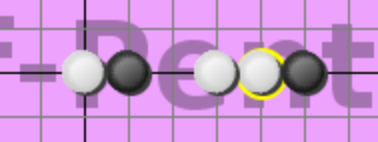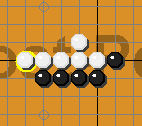|
Table of Contents Getting Started Join Privacy Policy Rated Game Policy EULA My Profile Playing Live Games Main Room Game Table Turn-based Games Game Rules Tutorials Player Rankings Game Database Forums Watches Donations Tournaments Eligibility Scheduling Games Playing Games Cheating Tournament Formats Single-Elimination Double-Elimination Swiss Round-Robin FAQ General FAQ Game Rules FAQ Applet TroubleShooting Java Web Start FAQ |
Playing - Game RulesThe rules for the games at Pente.org are pretty simple, yet the games themselves and the strategy behind the games is hard to master. So here are the rules, for help on strategy try the Tutorials. The tutorials also cover the rules of Pente with some helpful examples.
Common Rules All games are played on a 19x19 board of intersecting lines. Each player places stones on the intersecting lines (not in between the lines). Once a stone is played it can't be moved again (except if captured in certain games). All games start with player 1's first move in the middle of the board, except for Go, D-Pente, and DK-Pente. Play then continues by alternating turns until one player wins. Gomoku Gomoku is the simplest of the games. To win, place 5 of your stones in a straight continuous line (either horizontally, vertically or diagonally). Whoever does this first wins the game. One note, you must get exactly 5 in a row to win. 6 or more of your stones in a row is called an "overline" and does not count as a win, play continues. Pente Pente is like Gomoku but with a twist. You can win at Pente just like in Gomoku, by getting 5 of your stones in a straight continuous line. (Also in Pente you can win by getting more than 5 in a row, unlike Gomoku). The twist to Pente is that you can capture your opponents stones, removing them from the board. Capturing occurs if you place one of your stones on both sides of a pair of your opponents stones. For example, if the stones are like this XOO and you place your stone so it becomes XOOX, then your opponents stones are removed from the board, leaving X__X. Capturing is good to slow your opponent from getting 5 in a row, but you can also win at Pente by capturing. If you capture 10 or more of your opponents stones you win (5 or more captures). Another thing to realize is you can't play into a capture. If the board position is like this XO_X, and you place your stone such that the board is like XOOX, then your stones are NOT captured. (Note that Poof-Pente is a variation where you CAN play into captures) One final rule of Pente is called the "Tournament Rule". If you play rated games at Pente.org, the tournament rule is used. The tournament rule was proposed by Tom Braunlich to make the game more fair for player 2. It restricts player 1's second move so that player 1's second move must be at least 3 intersections away from the center of the board. Keryo-Pente Keryo-Pente is a variation of Pente proposed in 1983 by World Pente Champion Rollie Tesh. Again you can win by placing 5 in a row. The variation has to do with the captures, you can still capture 2 stones as in Pente, but you can also capture 3 stones in the same manner. In order to win by capturing you must now capture 15 or more stones. Although technically only a variation of Pente, games turn out to be very different. G-Pente G-Pente is a variation of Pente proposed by Gary Barnes. Again the reason for the variation is to make the game more fair for player 2. This variation restricts player 1's second move, just like the tournament rule. It additionally prohibits playing on the 4th and 5th intersections away from the center of the board that are one the same horizontal or vertical line as player 1's first move. (These moves are the most common second moves for white). D-Pente D-Pente is a variation of Pente proposed by Don Banks. Again the reason for the variation is to make the game more fair for player 2. This variation is very different from the others however. Player 1 places the 1st 4 moves on the board, 2 white stones, and 2 black stones. At this point in the game player 2 gets control. Player 2 decides to continue playing as player 2, or decides to swap seats and take over as player 1! After that decision is made, play continues just as in Pente with whoever is now player 1 making the next move. Hopefully you can see how this makes the game more balanced for player 2, in fact player 2 now has the advantage because player 2 decides after move 4 which side to play. So player 1 has to come up with a set of first 4 moves that are balanced, because if the position isn't balanced, player 2 will probably win (because they can swap!) Poof-Pente Poof-Pente is a variation of Pente proposed by Tom Cooley. The main difference is that you can play into a capture! (e.g., from XO_X player plays XOOX) then the stones are "poofed" (removed from the board and counted as captures). Normal captures are still allowed and the number of captures to win remains at 10 stones. Note that more than 2 stones could be poofed in one move, specifically up to 5 at once! Also note that my current implementation performs the following actions in sequence after a move:
 Boat-Pente Boat-Pente is a variation of Pente proposed to Pente.org by player zoeyk. Also known as "boat rules" Pente. Boat-Pente aka "Boat Rules" Pente was originally invented in the mid 1980's by a man named "Jay E. Hoff". The late Jay E. Hoff, (also know at this website by the player name of jayehoff) was the stepfather of player zoeyk (aka Zoey King). The main difference between this game and Pente is in the end game. Once a Pente is made (5 stones in a row), the game can continue as long as the opponent is able to capture across the Pente! So in the example game below white hasn't won yet because black can capture on the next turn, removing the Pente. If after black moves the Pente is still in place then white wins.  Capturing 5 pairs is still a win like in Pente and the tournament rule is used for rated games. Connect6 Connect6 was introduced by Professor I-Chen Wu at the National Chiao Tung University. The rules are similar to gomoku, the object is to be the first player to get 6 pieces in a row, either vertically, horizontally or diagonally. Player one plays one stone at the center of the board. After that each player gets to place two stones on the board at a time. More info at http://en.wikipedia.org/wiki/Connect6. DK-Pente DK-Pente combines the rules of D-Pente and Keryo-Pente. Go The rules of Go are a bit involved but a nice interactive tutorial can be found here. Here at pente.org we use a komi of 7.5 for all board sizes. Play continues until both players pass consecutively. After which the first player to pass gets to mark dead stones (stones of both sides they believe would have been captured eventually), and then the other player gets to accept the assessment of dead stones or reject it. In case of rejection, the game resets to the move before the double pass, and play continues. O-Pente O-Pente combines the rules of Keryo, Poof, and Boat Pente. Swap2-Pente Swap2-Pente is Pente with swap2 rules: The 1st player plays 3 stones, then player 2 decides to
Speed Games All of the above games can be played untimed, with a "normal" time limit, or as Speed games. Speed games are played so differently that they are really in their own category, so at Pente.org they are treated differently. Each player has two ratings for each game, one for normal or untimed games, and one for speed games. This helps the ratings system stay more accurate since each players skills at speed vs. normal games can be very different. Note: Do not create a separate account for speed games. So how does Pente.org define a Speed game? A speed game = (initial time minutes * 60 + incremental time seconds * 15) <= 330 A normal game = (initial time minutes * 60 + incremental time seconds * 15) > 330 Some examples: Initial time/Incremental time (5/0) = Speed game 5 * 60 + 0 * 15 = 300 Initial time/Incremental time (6/0) = Normal game 6 * 60 + 0 * 15 = 360 Initial time/Incremental time (5/2) = Speed game 5 * 60 + 2 * 15 = 330 Initial time/Incremental time (4/6) = Speed game 4 * 60 + 6 * 15 = 330 Initial time/Incremental time (4/7) = Normal game 4 * 60 + 7 * 15 = 345 Initial time/Incremental time (1/5) = Speed game 1 * 60 + 5 * 15 = 135 When the time controls are updated in a game table, the above formula will be run to determine if the game is a speed game or not, and you will know the type of the game because the game board will display "Speed" if the game is a speed game. << Turn-based Games >> Tutorials |